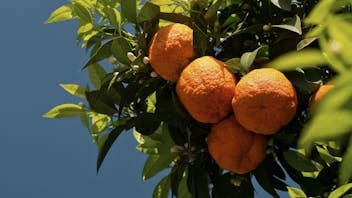Product Overview
Our Petitgrain sur Fleurs essential oil has a distinct, fresh, green floral, linalyl acetate-like, somewhat sharp, terpene-like aroma with a soft, sweet-woody, tenacious undertone. This oil is also called Petitgrain Neroli in the States, but the true designation is Petitgrain sur Fleurs, meaning ‘Petitgrain over flowers’. It is produced from the leaves and twigs that are separated from the blossoms both during the height of Neroli season and at its close when many blossoms remain on the tree. It is these 'yearling' leaves along with the remaining blossoms that impart the softer, more floral character to this Petitgrain oil.[1] There are only a select few distillers making this oil and we are delighted to find it available!
Petitgrain sur Fleurs is one of the better known co-distillations with plant material sourced from the same type of tree, Citrus aurantium var. amara.[2] This specific evergreen tree also provides five other oils; from the blossoms: steamed distilled Neroli and solvent extracted Orange Blossom Absolute; from the leaves: solvent extracted Petitgrain Absolute; from the leaves and twigs: steam distilled Petitgrain Bigarade; and expressed from the fruit peels: Bitter Orange oil.
Since the 1860s when nearly all citrus orchards, except for Bitter Orange trees, were destroyed due to root rot and gum disease, it has been the practice to use the highly resistant root stock of this specific citrus, Citrus aurantium var. amara, to propagate Lemon, Sweet Orange, Mandarin, Grapefruit, and Bergamot trees.[3]
Petitgrain has been called “poor man’s Neroli” as it is less expensive than Neroli essential oil yet offers many of the same benefits and uses. Due to its high linalyl acetate content, the aroma of Petitgrain is often used in calming massage blends, nighttime sprays and diffuser blends, after-shaves, and preparations for oily and congested skin.
1 Industry communication.
2 Arctander, Steffen. Perfume and Flavor Materials of Natural Origin, 1960, p. 526.
3 Guenther, Ernest. The Essential Oils, Vol. III, 1949, pp. 89, 228.



